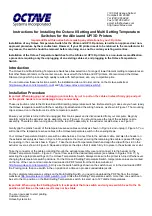
DSPF/RSPF Lab
Objective
: After completing of this exercise, you will be able to disassemble/reassemble and troubleshoot the DSPF.
Note:
Be sure to find the correct section in the Service Manuals to perform each procedure for this lab.
This lab pertains to SHARP
®
Monochrome DSPF/RSPF units from several MFP Segments.
Segments are described as:
Segment 1: 11 – 20 ppm Small or home offices
Segment 2: 21 – 30 ppm Small offices
Segment 3: 31 – 40 ppm Small to mid-sized offices
Segment 4: 41 – 69 ppm Mid-to-large offices
Segment 5: 70 – 90 ppm Very large offices and/or large print runs
Segment 6: 91 + Print for pay shops / Commercial-sized print runs
PROCEDURE 1:
1.
Following the steps in the service manual, remove the Front and Rear covers of the document feeder.
2.
Place originals in the feeder and make copies. Watch as it performs its normal operations.
PROCEDURE 2:
Component ID
Using the
External view and internal
structure section of the service manual, locate the components listed and
use SIM 2 to test them.
1.
SCOV (DSPF/RSPF upper door open/close sensor)
What will happen if you unplug the sensor and power on the MFP?
2.
STUD (DSPF/RSPF document feed tray upper limit sensor)
What will happen if you block the sensor and make a copy using the document feeder?
3.
SPFC (DSPF/RSPF document feed clutch)
What will happen if you unplug
SPFC
and make a copy using the document feeder?
What jam code is recorded?
4.
STRRC (DSPF No.1 registration roller clutch)
What will happen if you unplug
STTRC
and make a copy using the document feeder?
What jam code is recorded?
5.
STRC (DSPF transport roller clutch)
What will happen if you
unplug
STRC
and make a copy using the document feeder?
What jam code is recorded?























